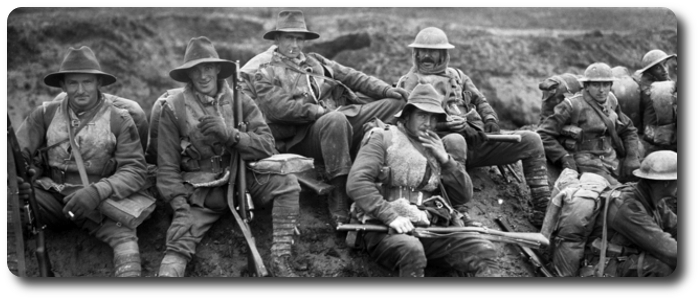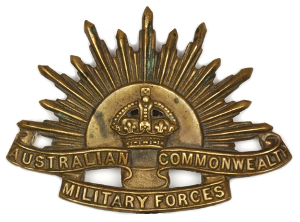Topic: Army Rations

"On Its Stomach"
The Fighting Force of an Army
Australian's Ration Allowance
Food in Depot Camps
The Age, Melbourne, Australia, 24 March 1918
 Whatever the Australian troops may be called upon to undergo in the nature of hard rations in the field, when they are in the depot and standing camps in Australia they have abundant and excellent food. Their ration is more liberal than that of almost any army in the fighting fields today, or amongst the forces of the mobilised central powers. Bully beef and biscuits, jam, biscuits and bully beef, jam, alternated, disguised with a dash of vegetables, was the ration at Anzac. It was a good ration, too, for any army fighting and moving every day, and with an abundant water supply available. But it was monotonous diet for such a campaign as Gallipoli, and unhealthy as well when the water supply was so strictly limited. Casting aside the condiments, and the little extras that came to hand, this was the staple food of the Australian army in the field. Compare it with the 1 ¼ lb. bread (or 1 lb. biscuit), and 1 1/2 lb. meat (or 1 lb. fresh or salt fish), 1 lb. potatoes and 8 oz. mixed vegetables that the troops at the camps throughout the Commonwealth have as the basis of their daily meals. Flour, rice and curry powder are a weekly ration, which helps the cooks to give variety to a breakfast, lunch or dinner. An army fights on its stomach; it builds up reserve in physique, muscle and toughened sinew by long hours of drilling, marching, exposure to the elements; it lives and prospers on the rations that are provided after a day of vigorous training and campaigning.
Whatever the Australian troops may be called upon to undergo in the nature of hard rations in the field, when they are in the depot and standing camps in Australia they have abundant and excellent food. Their ration is more liberal than that of almost any army in the fighting fields today, or amongst the forces of the mobilised central powers. Bully beef and biscuits, jam, biscuits and bully beef, jam, alternated, disguised with a dash of vegetables, was the ration at Anzac. It was a good ration, too, for any army fighting and moving every day, and with an abundant water supply available. But it was monotonous diet for such a campaign as Gallipoli, and unhealthy as well when the water supply was so strictly limited. Casting aside the condiments, and the little extras that came to hand, this was the staple food of the Australian army in the field. Compare it with the 1 ¼ lb. bread (or 1 lb. biscuit), and 1 1/2 lb. meat (or 1 lb. fresh or salt fish), 1 lb. potatoes and 8 oz. mixed vegetables that the troops at the camps throughout the Commonwealth have as the basis of their daily meals. Flour, rice and curry powder are a weekly ration, which helps the cooks to give variety to a breakfast, lunch or dinner. An army fights on its stomach; it builds up reserve in physique, muscle and toughened sinew by long hours of drilling, marching, exposure to the elements; it lives and prospers on the rations that are provided after a day of vigorous training and campaigning.
They trained us in the desert, fed us like fighting cocks, taunted us and flung us against the Turks; no wonder we thrashed them, was the summing up of a soldier from the battle field of Lone Pine. The scene at the feeding centre at a typical standing camp is interesting.
Behind the rows of tents a Royal Park were five blackened chimneys sticking like stems out of white painted brick works. The first four letters of the alphabet were blackened on the white walls, one for each company of a battalion, and an H.Q. for headquarters and the cooks. A red-roofed shed covered five rows of fire trenches, and a cook house and a picturesque garden of flowers surrounded the whole. That was the cooks' lines of a battalion. There are three at Royal Park.
Sergeant Cook here. very straight, very tall. And very burned, the head cook, the chef, as he is familiarly called, stepped out from a group of six men who were bending over a row of steaming dixies. What's for dinner?
Now it had been obvious to the senses that the ration was roast meat and onions. As a matter of fact it was a more elaborate meal than one would suspect, consisting of either baked potatoes and roast leg of lamb, or boiled mashed potatoes and boiled mutton and tea. The cook explained:
But different from the old camping days, sir, when the militiamen went to Semour and those places. Better'n we had in South Africa in any of the camps I was in. No man need complain, there is enough for all, though to speak plainly we could do with a bit more meat when the camp is a bit empty; but when there is a full battalion, a thousand odd men, then it is alright and a bit to spare. No, no waste, except it might be very occasional when a squad of a hundred or so are sent off up country , and they don't bother to carry their ration, trusting to luck to get it on the journey. It doesn't happen often. Got to watch some of the lads that they don't go and take a double ration on me. Like to try the soup? We use up a bit of the rice that is part of the ration and onion and the stock we get from last night's boiled meat. Good as meat as you would wish to get anywhere; they have sent us along a number of ewes, more's the pity, for after the drought they fattened them up and they brought good prices. Yes, I was in a line regiment is South Africa, and then cook, and when I can back went on to a station. Yes, ought to be used to cooking for numbers. Best way to see that the men appreciate what they get is to have a cook at the bins. The chaps who contracted for the waste for his pigs don't get much out of it; seldom quarter filled. Only time as when the time is too short to peel the potatoes—no use leaving them in their jackets—men too hungry to peel them I suppose. And the sergeant cook, smiling, commences to lift the lids of the huge cauldrons of stews and sizzling potatoes.
Time was, not five years ago, when it was only after the greatest effort that the cooks could be induced to dig their fire trenches narrow enough just to rest a dixie—that very handy cooking utensil of the army—on, or go to the trouble of constructing an Aldershot oven. To-day the fire trenches are bricked to the required width, the draught being created by the chimney stack at the end. The cooks, anxious at all times to economize labor, have found that the large-sized rubbish bins (there was something very familiar about these cauldrons) make the finest cookers, boiling or roasting enough meat for over 100 men. It saves in this way the labor of polishing the dixies bright again after every meal. They are ready piled, handy to be used for distributing the ration and tea into the tents.
A shower of sparks is flung in the air from a fire that is burning under an ordinary square iron tank. Here it is possible at all times day and night for hot water to be obtained; no restriction is placed on the troops for getting what they require for washing or bathing purposes.
It is all a little too luxurious for a camp! Between the comfort of a home and the hardships of the firing line lies a huge gulf. Such small luxuries as these help to bridge it; the spirit and the fighting power of the army depends on its stomach. Exactly to-day every Australian officer and soldier while in camp has for his scale of ration:—
- 1 ¼ lb. bread or 1 lb. biscuit.
- 1 ½ lb. fresh meat or 1 lb. fresh or salt fish.
- 1/3rd oz. coffee.
- 1/32nd oz. pepper.
- 8 ox. mixed vegetable or 2 oz. cheese.
- 1 lb. potatoes.
- 3 oz. sugar.
- ¼ oz. salt.
- ½ oz. tea.
- ¼ lb. jam.
Weekly he has ½ lb. flour and the same of rice, and 1 oz. curry powder. In the hands of trained cooks it is a ration calculated to strengthen the stomach to fight, to 'stick it' to the bitter end, in every true Australian.

